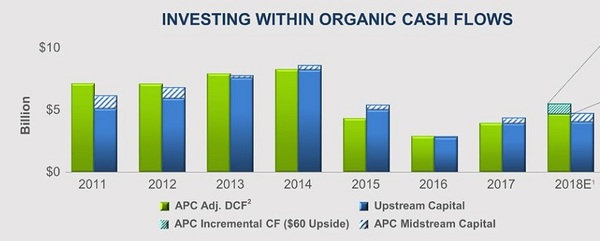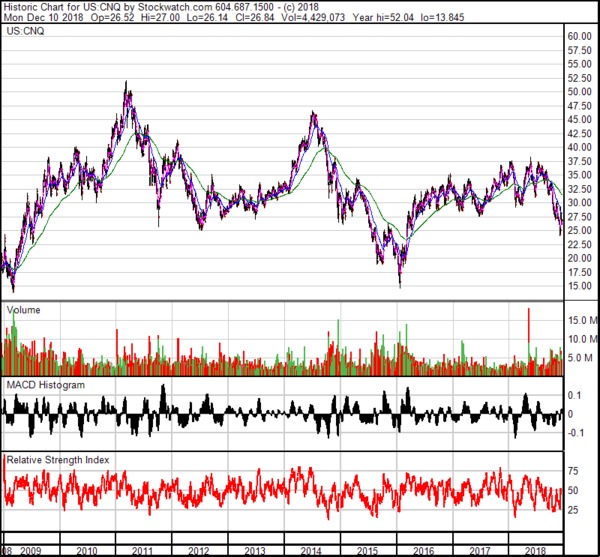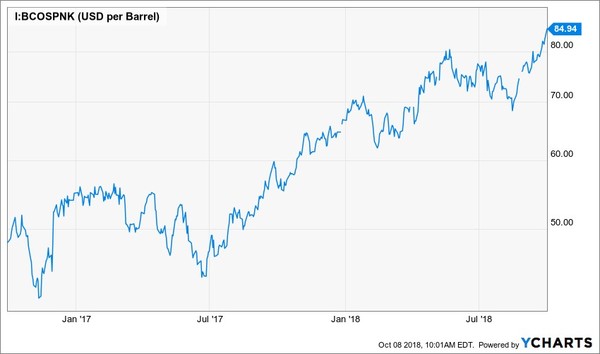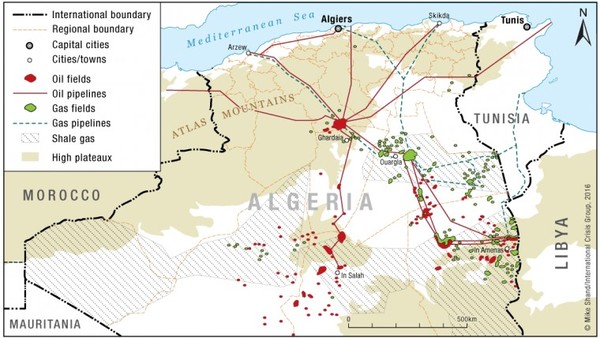In this short video, I tell you where I think the oil price is going in 2019, and three factors that could make oil have a big swing in price – either up or down. Click on my picture below to hear my thoughts (and sign up for my YouTube channel!), or scroll down the page to read a rough transcript. Thanx for watching and have a Happy New Year!
Hi, I’m Keith Schaefer from the Oil and Gas Investments Bulletin. My job is to give my subscribers the best money-making ideas in energy.
So what do energy investors have to look forward to in 2019? Where can we make money?
The Big Lie of 2018 was that few oil stocks followed the oil price upwards in the first nine of months of 2018 – and of course ALL oil stocks collapsed with oil in the last quarter of the year.
I see that happening again in 2019 – in the sense that I don’t see oil producers as the best place to make money in energy this year. I’m neutral on oil in 2019; I see volatility calming down and WTI prices a lot more stable in the low-to-mid-$50s. That’s not good for most oil stocks. But how could I be wrong?
I see the Three Big Factors for oil moving up or down in 2019 being
- Saudi Arabia and
- Venezuela.
- Will the world have a small recession this year, lowering demand growth
The US is NOT a big factor, because investors know what is going to happen there – production will likely increase another million barrels a day. To me, that’s a given. US management teams are just built to grow.
They can’t stop themselves and will continue to grow production on thinner and thinner margins, i.e. lower prices.
Even with a greater commitment to live within cash flow, I see US production jumping up at least one million barrels a day – which should take care of most of the increased demand in 2019. I think WTI would have to stay close to $45/b for at least a couple months for US production growth to slow. The rig count would have to spend most of the year at 600 for production to flatline. It’s now over 1000.
So that means it’s up to the Saudis to decide if they are willing to give up that million barrels a day to even sustain Brent prices here at $55-$60, then investors can make money on some of the larger producers, whose share prices have been hit hard.
I hear a lot of oil commentators talk about a price that the Saudis NEED to preserve social stability. I’m not sure I believe that, but certainly that number is $70-$80/barrel.
The other big wild card is Venezuela – if their production keeps collapsing, then oil could do better than I expect.
And folks, I don’t care how long you’ve been studying oil or how many letters are behind your name – PhD or whatever – nobody knows how those two countries will play out in 2019.
The third big factor in 2019 will be oil demand. For the last few years, oil demand has increased about 1.4-1.5 million barrels per day, and the world is now using 100 million barrels a day of oil. That’s a huge number!
But a lot of big consuming countries are slowing down. China is certainly slowing down. Industrial production growth is down to the lowest level since the 2008 financial crash at 6%, and retail sales growth is down to 8%.
Germany has already had one quarter of negative GDP. And as strong as the US economy is, it’s actually overheating right now, and that usually means higher interest rates and a slowdown.
Now, I am not talking about a big recession… I’m just talking about a normal business cycle slowdown. Industrial commodities like oil, copper, zinc and steel all had sharp downturns in Q4 18, and of course, the stock market also tanked.
Again, nobody knows if there will be a recession or not, or how that might impact oil demand.
There’s a couple other things to think about oil. Despite the fact we have lots of oil… inventories are still at normal to high levels – there is really very little spare capacity in the world – and I really mean ZERO. Everybody is producing as much as they can at any given time. I really thought the world would give oil a bit of a premium there, but that is not happening.
It’s true that if Africa – particularly Nigeria and Libya – could find peace, then oil supply would certainly overwhelm demand. But I see that as a remote chance, so it’s not part of my Big 3 Factors.
To recap:
- I think WTI will average in the low-to-mid $50s per barrel.
- I think Brent will average just over $60/b
- The 3 Big Factors for oil in 2019 – that are unknowable – are
- What will the Saudis do
- Will Venezuela production collapse
- Will there be a mild global recession
I think the uncertainty here will keep investors out of small cap oil stocks. The larger producers are trading so cheap now – I follow a couple that are 2-4 x cash flow, which to me is unbelievable – that small stories make little sense now.
There are only two oil stocks right now that to me are so compelling I want to actually increase my position. I’ll tell you about them – and a couple other money-making ideas – in my next video.
Have a Happy New year and thank you for watching.
Click here for monthly access $ 59 a month (no refunds)
Click here for quarterly access $ 149 per quarter (30 days no-questions refund)





























